Tom Clancy’s Ghost Recon: Future Soldier – MP, Campaign, and Film Preview
by Dom
|
The modern warfare genre is tried, tested and generally approved by a salivating general public. Publishers and developers have invested a lot of time in generating content that takes place on the modern battlefield (usually with generous commercial success). But the genre has become stale – even the most hardcore Battlefield 3 or Modern Warfare 3 fan can see that – there just hasn’t been a great deal of change in this area over the last few years.
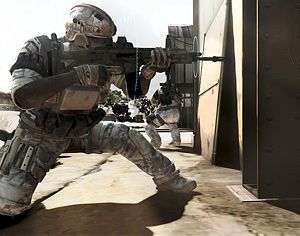 Ghost Recon: Future Soldier doesn’t change any of that. Not really. It’s still a game rooted in taking down angry Russians, African warlords or Middle-Eastern dictators. It hasn’t done anything revolutionary, nor has it changed the way I think about shooters set, well, now (or in the not-too-distant-now). It has, however, shown there is vast potential for growth within this haggard area of gaming – if playing through the various modes of Ghost Recon: Future Solider has taught me anything, it is that Ubisoft have a lot of innovation up their sleeves, and all they need is a bit more time and support and they can deliver something truly spectacular. Future Soldier has been plagued by a slew of release-date delays and set-backs, but it all seems for the best; Ubisoft Paris have taken no gambles in ensuring this game is as good as they could make it.
Ghost Recon: Future Soldier doesn’t change any of that. Not really. It’s still a game rooted in taking down angry Russians, African warlords or Middle-Eastern dictators. It hasn’t done anything revolutionary, nor has it changed the way I think about shooters set, well, now (or in the not-too-distant-now). It has, however, shown there is vast potential for growth within this haggard area of gaming – if playing through the various modes of Ghost Recon: Future Solider has taught me anything, it is that Ubisoft have a lot of innovation up their sleeves, and all they need is a bit more time and support and they can deliver something truly spectacular. Future Soldier has been plagued by a slew of release-date delays and set-backs, but it all seems for the best; Ubisoft Paris have taken no gambles in ensuring this game is as good as they could make it.
The best way of tackling everything about Future Soldier would be to divide and conquer; so please read on for a detailed preview of the campaign mode, the multiplayer beta and the short film that is to be released alongside the main game.
Campaign
I’ll start off by saying this: the writers of this game have made a fundamental error. An error I have begun to dub “Halo: Reach Syndrome.” This game is a balls-to-the-wall stealth/war shooter, not a narrative driven, cut-scene heavy JRPG. The majority of people aren’t going to play this game to learn more about the characters; they just want to pop carbine bullets through people’s heads. At the preview event, we were only given “vertical slices” of the game – that is to say, we got to play this mission. Then that mission. Then this mission. Due to the preview build of the game, we didn’t see how the game flowed, with all the cutscenes merging together. I was told later (by Jean-Marc Geffroy, Creative Director of GRFS) that there are about one and a half hours of cinematics in the game, and that some of these involve direct input from the player in order to advance them. I’m still sceptical, however.
The main reason for my scepticism is – from what I saw of the game – the characters are just so boring. You’ve got a squad of four (the game makes a lot of this; more on that later), and you are usually tasked with being dropped in hostile enemy territory, ghosting your way through a busy and dangerous map and either extracting an ally, destroying something nuclear or executing a nasty man. There isn’t really a lot of room to crowbar characterisation in, to be honest. Whilst there are some nice lines here and there, and you do feel differently for different characters, the game repeatedly falls on its face in terms of real character development.
 This is overshadowed by just how well the game is put together. During the preview session, the journalists and guests were treated to a Q&A with Ubisoft’s IP Development Director Adrian Carey and (as mentioned previously) Future Soldier’s Creative Director, Jean-Marc Geffroy. While I know it’s their job to sell the game, something about their outlook and optimism on it seemed too genuine to be sales charm. The pair seemed very keen to reinforce how ‘realistic’ and ‘authentic’ the game is; the development team worked very closely with ‘SEAL Team 6’ to make the it seem as genuine and real as possible.
This is overshadowed by just how well the game is put together. During the preview session, the journalists and guests were treated to a Q&A with Ubisoft’s IP Development Director Adrian Carey and (as mentioned previously) Future Soldier’s Creative Director, Jean-Marc Geffroy. While I know it’s their job to sell the game, something about their outlook and optimism on it seemed too genuine to be sales charm. The pair seemed very keen to reinforce how ‘realistic’ and ‘authentic’ the game is; the development team worked very closely with ‘SEAL Team 6’ to make the it seem as genuine and real as possible.
“We tried to give you a sneak-peek of the battlefield of tomorrow,” said Adrian Carey, “we wanted to give you a look at how Spec. Ops people think, move and act.” This much comes through. The main squad you play as (Pepper, Ghost Lead, Kozak and 30K) are all mo-capped from real marines. Initially, Ubisoft hired actors to suit up in the silly mo-cap balled suit, but after a few days of instruction from an ex-squaddie, they decided to get the squaddie himself to cap all the movements. Apparently, they only ever needed one take to get the movements they required. This shows – there are “over 2,500 animations on the main character alone,” claims Carey. I can believe that; as opposed to futuristic games like Halo or machismo maelstroms like Gears, Future Solider has got a certain… well, realism to it that makes it seem muted and more intimate. By the end of filming, they had the whole ex-squad capping for all the breaches, cover-taking and reloading. Visually, this comes across beautifully, with a level of human accuracy that is more cinematic than you’d expect.
 |
 |
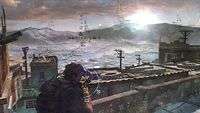 |
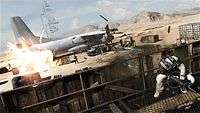 |
 |
 |
In terms of gameplay, this is communicated with an unfortunate clunkiness. Both in the multiplayer and in the campaign, I have suffered from trying to ‘stick’ to cover, only to end up sprinting stupidly across the map like a suicidal maniac. Sometimes when I want to pop my head out of cover to examine my surroundings, I’ve ended up just standing, awaiting a bullet to my soft, vulnerable brain. You’ve got a slow and cumbersome sprint that I tended not to use because you can’t control where you’re going and usually end up plastering yourself to a wall. The most accurate metaphor I can think of is that handling your character is a little like driving a supercar on a wet road – you can tell you’re in control of a powerful and visceral force, but sometimes it just veers a little on the side of unresponsive.
 Other than that, the controls are smooth and accurate – the aiming is precise and (as you’d expect) realistic, and the recoil from firing your weapons is controlled but challenging. The fact that this game is an over-the-shoulder ‘third-person’ shooter, rather than a FPS works to its credit. Back to the whole characterisation debate, Adrian Carey says “OTS shooters help aid relation to the characters – you can actually see who you’re playing as, and that gives the player a certain affinity with the character they control.” When asked about whether or not people will care about the Ghost squad, he responded with “characterisation is in [the player’s] hands, really.” This statement doesn’t imbue me with a lot of confidence – it seems like a bit of a cheap sell, really. Carey continued, however, and debuffed my doubts by claiming that the game was built to accommodate four-player co-op, and that the whole thing revolved around teamwork. The characters are basically avatars for real people to project themselves upon (which might explain their bland personalities).
Other than that, the controls are smooth and accurate – the aiming is precise and (as you’d expect) realistic, and the recoil from firing your weapons is controlled but challenging. The fact that this game is an over-the-shoulder ‘third-person’ shooter, rather than a FPS works to its credit. Back to the whole characterisation debate, Adrian Carey says “OTS shooters help aid relation to the characters – you can actually see who you’re playing as, and that gives the player a certain affinity with the character they control.” When asked about whether or not people will care about the Ghost squad, he responded with “characterisation is in [the player’s] hands, really.” This statement doesn’t imbue me with a lot of confidence – it seems like a bit of a cheap sell, really. Carey continued, however, and debuffed my doubts by claiming that the game was built to accommodate four-player co-op, and that the whole thing revolved around teamwork. The characters are basically avatars for real people to project themselves upon (which might explain their bland personalities).
The dev team have obviously paid a lot of attention to detail with GRFS, especially in terms of aesthetics and making your gameplay experience as natural as possible. Every scenario has dialogue between the characters – in the 3rd level (which is a snow-covered Russian outpost – this being a Tom Clancy game and everything) you have control over a war mech called ‘Warhound’ (which is actually based on real tech, scarily enough). Every time you wipe out a good number of enemies with a single mortar blast, or take out structures with a guided missile, your team-mates will give you ooh-rah-esque feedback. Same goes for if you’re tracking someone (there’s a lot of that), or if you pull of a good-range headshot. Or if you mark someone. Or if you do anything. All of this dialogue seems natural enough, although I don’t really know what ‘natural’ is in the context of a black-ops mission.
Then there is the pace and tone of the whole game. Jean-Marc Geffroy explains the decision in moving away from the more micro-management centred approach of previous instalments of the games: “We wanted to give you the option to be more hectic. 70% of the game can be played in stealth.” They opted to take out the overtly tactical approach of the first few Ghost Recon games because – as is their mantra – they wanted it all to be more realistic: “The option to say ‘go behind that wall’ or ‘do this, do that’ was removed because Special Forces don’t need that input – the leader’s movements dictate the teammates’.” Again, this shows. The friendly AI is probably some of the most intelligent I’ve seen in a game to date – your squad is pinned to you. If you’re too slow on the uptake sniping an enemy, expect your fellow soldiers to take them out before you. Same goes for movement; once you cross certain trigger points or thresholds, your team will tactically decide where to go. Again, the programming behind all this was developed alongside real Spec. Ops squad members – their input generated the tactical, realistic Ghosts you’ll see in-game.
 The enemy AI, however, is nothing short of idiotic if left to their own devices. I played the game on the stalwart ‘Medium’ setting, but the only difficulty I could discern was the increased damage you take. The AI are just dumb – if you play through as a full-on Ghost (stealthy-does-it), you will have no difficulty going through, level-to-level. The enemies follow certain paths, with certain sight-lines, and if you can take advantage of that, there is not a lot of challenge to the game (it’s still fun, though). Once you alert your foes to your presence, the difficulty picks up – enemies will suppress you whilst others flank, and you have to rely on your teammates to pull you out of hot water. If you can mark all of your enemies and get your team to snipe them alongside you (a very nice touch in single-player; probably a bit more challenging in co-op), and kill who you’re supposed to, when you’re supposed to do it, you can take advantage of the badly designed opposition with ease.
The enemy AI, however, is nothing short of idiotic if left to their own devices. I played the game on the stalwart ‘Medium’ setting, but the only difficulty I could discern was the increased damage you take. The AI are just dumb – if you play through as a full-on Ghost (stealthy-does-it), you will have no difficulty going through, level-to-level. The enemies follow certain paths, with certain sight-lines, and if you can take advantage of that, there is not a lot of challenge to the game (it’s still fun, though). Once you alert your foes to your presence, the difficulty picks up – enemies will suppress you whilst others flank, and you have to rely on your teammates to pull you out of hot water. If you can mark all of your enemies and get your team to snipe them alongside you (a very nice touch in single-player; probably a bit more challenging in co-op), and kill who you’re supposed to, when you’re supposed to do it, you can take advantage of the badly designed opposition with ease.
If you’re a gun nut, the Gunsmith menu will have you salivating for hours. Every aspect of every available gun is customisable: the stock, the gun barrel, the muzzle, the trigger, the magazine, the paint, the optics, the rail… all of them are interchangeable (I’ve almost certainly missed some out, too). These all have repercussions in-game; however you decide to kit out your weapon affects control, range, rate or fire and, obviously,power/damage. US weapons are unlocked through campaign progression, and the Russian (usually superior) weapons are unlocked through completing specific challenges in-game. To be honest, in both the campaign and on the MP beta, I’ve been playing with various set-ups and customisations and I can’t really tell that much difference in the in-game outcome. Optics are obvious (for their visual effect), as is the trigger system (full auto or burst-fire), but as far as things like changing the gas system (which usually affects control and rate-of-fire), it all seems pretty negligible.
 |
 |
 |
 |
 |
 |
The sound was pretty average, to be honest. The effects were all taken from real sound banks (to my understanding), and there are some very precise and technical sounds to be heard. All the explosions and weapons sound legitimate, and the score slides nicely between tension-building low-end drones and synths for the stealthy bits, and (typically) aggressive rockiness for the balls-out action sequences. The voice acting is good, but not amazing, and each character has been given a thick accent which helps identify who’s speaking when all Hell is being let loose around you.
Graphically, the GRFS looks like it should have been released two years ago. After seeing some of the trailers and gameplay shots of this title over the years, I was expecting mind-blowing, ground-breaking visuals. In all honesty… it’s forgettable. The graphics aren’t bad, but they certainly aren’t on par with some of the more impressive releases over the last year. The visual designers have put some nice touches in, however. Everything you see comes through W.A.R (Weapon Augmented Reality – a lesson in acronymic originality), and so there are nice little things you’ll notice around the map that your on-board computer systems pick out. One thing that really impressed me was when my visor got blown off (or something, I was too busy focusing on everything that was going on around me) and my character put it back on. For the next few minutes, on the bottom left of my screen, there were smudged – and very genuine – fingerprints obscuring part of my vision. When you switch into the optical camouflage, the graphics actually improve; the distortion/translucency effect given off by the camo is an impressive thing to behold.
 The missions within the game are entertaining enough. Standard shooter fare, really; all the levels I played could be interchangeable with any CoD, Battlefield or other shooter release. The maps are nice and airy; there are various routes to your objectives and you and your team are free to explore them. The missions themselves are all very ‘go here, do this’, but I wouldn’t want anything else from a game like this. There is some nice deviation from the norm here and there, but nothing too extravagant. One of the missions sees you escort the terrifying mecha Warhound into a Russian base and rain all kinds of death down upon them. Between the mortar-fire and the bullet-dodging, you get to see quite a few inventive cinematics revolving around this metal beast.
The missions within the game are entertaining enough. Standard shooter fare, really; all the levels I played could be interchangeable with any CoD, Battlefield or other shooter release. The maps are nice and airy; there are various routes to your objectives and you and your team are free to explore them. The missions themselves are all very ‘go here, do this’, but I wouldn’t want anything else from a game like this. There is some nice deviation from the norm here and there, but nothing too extravagant. One of the missions sees you escort the terrifying mecha Warhound into a Russian base and rain all kinds of death down upon them. Between the mortar-fire and the bullet-dodging, you get to see quite a few inventive cinematics revolving around this metal beast.
Overall, this is a game to look out for. Playing through three levels of the campaign and racking up ten plus hours on the multiplayer has got me excited enough to want to pick this one up. There are flaws, of course, but then again all games have flaws. Future Solider isn’t as innovative as it thinks it is, but it has got a few nice features worth playing for. If all games showed the passion and dedication that this game has shown through its three year dev cycle, this industry would bloom with games that offer pure entertainment. As it is, GRFS verges on gimmickry, but never crosses the line. The optical camo isn’t over-used, and the fancy tech you’ll see is never made redundant by repetition. This game is a Ghost in the shadows, waiting to take you down with surprise. (I hope that bloody awful analogy communicates my opinion enough to have made it worth it).
Multiplayer
 Where do I begin? The multiplayer is a good design, built solidly on teamwork. The very first thing (probably the only thing) you need to know about the MP for Future Soldier is that you must work as a team. If you don’t, you’ll get nowhere. It reminds me a fair amount of Homefront’s MP, without the hassle. You are given three classes to choose from (each customisable) and can adjust your gameplay accordingly. For example, I tend to play as a scout, which allows me to boot up my tactical camouflage and wait in bottlenecks to snipe and slaughter any who cross my path. This is particularly effective in the tight nooses around objective locations – players tend to be so desperately obsessed with diffusing an EMP bomb before it goes off that they neglect to watch their flanks. The same goes for defending a sector of the map, as anyone who comes in and tries to occupy it will usually reckon that they’ve got it easy when they see one guy (typically an engineer) hunkered down near the objective. Then the defenders shoot and the enemy drop to the floor, right on cue.
Where do I begin? The multiplayer is a good design, built solidly on teamwork. The very first thing (probably the only thing) you need to know about the MP for Future Soldier is that you must work as a team. If you don’t, you’ll get nowhere. It reminds me a fair amount of Homefront’s MP, without the hassle. You are given three classes to choose from (each customisable) and can adjust your gameplay accordingly. For example, I tend to play as a scout, which allows me to boot up my tactical camouflage and wait in bottlenecks to snipe and slaughter any who cross my path. This is particularly effective in the tight nooses around objective locations – players tend to be so desperately obsessed with diffusing an EMP bomb before it goes off that they neglect to watch their flanks. The same goes for defending a sector of the map, as anyone who comes in and tries to occupy it will usually reckon that they’ve got it easy when they see one guy (typically an engineer) hunkered down near the objective. Then the defenders shoot and the enemy drop to the floor, right on cue.
Like most objective-based MP experiences, defending is far easier than attacking. This isn’t fun, especially if your first objective is to acquire something already under enemy control. The three classes seem very rock-paper-scissors: scout beats soldier, soldier beats engineer, engineer beats scout (or not, depending on your play style/teammates). But that’s been the case in the vast majority of my games. This is why teamwork is so important – if you try and bounce off somewhere and selfishly add to your kill count, you’ll end up being drowned under the opposition. Stick with your mates and play tactically and you’ll stand a chance.
There are a few nice features in Future Soldier that are genuinely fresh and innovative: the sensor grenade can be thrown like a normal grenade and pings out a sonic echo that puts any enemy in range on your teammates’ and your maps/visors. You can also ‘data mug’ your enemy’s positions to get fresh intel on locations and set-ups. This is good – if your enemy gets hold of this information, the game immediately gets more tense. The tidal nature of battle is exciting, and something you don’t see in a lot of games anymore. You’re always one objective away from getting one up on the other team, and that presses you on to achieve it – objectives aren’t just points, and that makes a lot of difference.
EMP blasts are common, too – if you’re victim to one, you can’t use, well, anything. Your Augmented Reality goes down, so your whole HUD goes, too. This, again, is exciting; the hunter becomes the hunted and if you don’t think quick, you’ll end up waiting to be respawned (which is a surprisingly painless process – you rarely have to wait more than five seconds). When you respawn, there is only one designated spot in the map to spawn to per team (and you’ve got no idea how happy this makes me). This prevents spammy nine year old Americans waiting with a shotgun to blow you to bits when you spawn, teabag you, then call you a twat. Your other option is to spawn directly onto a teammate (which is becoming welcomingly common in shooters). This adds another dimension to your tactical approach – if everyone on your team dives into combat and gets themselves killed, you’ve all got to start from your end of the map. This gives the enemy time to fortify anywhere they want, and make it far more difficult for you to penetrate their defences. Being a sniper helps here – I tended to stay back when everyone around me threw themselves head-first into combat. When they all died, they all spawned on me again, and the whole deathly cycle repeated anew. I wasn’t too fussed… I was steadily picking people off, and all those people using me to jump into the action felt empowering.
 The game is solid and fair, and, like the multiplayer, has some very nice things on offer. There are some major sticking points, though, and they succeed in devaluing the whole experience. The most noticeable of these are the controls and handling. I have the same grievances with the MP as I did with the campaign in that sticking to cover is clumsy and inconsistent, and sometimes your man on the screen just doesn’t respond as you expect him to. It’s a shame that a game as promising as this is mired by something as fundamental as bad controls. (I must mention, however, that the build I played in campaign mode was preview code, and the MP is Beta, so this may well be addressed, going forward). Another flaw is the almost schizophrenic nature of the damage you deal. Using the same gun, I could get body shots and take someone down in one or two bullets. Other times, I’d land up to four/five hits and my victim would continue, sometimes not even aware I’d been shooting at them (other times I’d get spotted and slaughtered, predictably). Again, I’d put this down to it being Beta code.
The game is solid and fair, and, like the multiplayer, has some very nice things on offer. There are some major sticking points, though, and they succeed in devaluing the whole experience. The most noticeable of these are the controls and handling. I have the same grievances with the MP as I did with the campaign in that sticking to cover is clumsy and inconsistent, and sometimes your man on the screen just doesn’t respond as you expect him to. It’s a shame that a game as promising as this is mired by something as fundamental as bad controls. (I must mention, however, that the build I played in campaign mode was preview code, and the MP is Beta, so this may well be addressed, going forward). Another flaw is the almost schizophrenic nature of the damage you deal. Using the same gun, I could get body shots and take someone down in one or two bullets. Other times, I’d land up to four/five hits and my victim would continue, sometimes not even aware I’d been shooting at them (other times I’d get spotted and slaughtered, predictably). Again, I’d put this down to it being Beta code.
Aside from that, there are a few slight niggles, but nothing too bad. Character progression seems a bit too slow for my liking; you don’t level up very quickly at all, and that’s only the first few levels… I dread to think what it’s like when you reach the higher ends. I’ve experienced a few glitches with levelling up, too: I got booted from a lobby (due to host disconnection) as I reached level four and was allowed to choose a perk for my weapon (this happens periodically, and is a good incentive to advance). After this, I could find no way back to choose my reward and was subsequently locked out of the screen to get them. I could see my 12x optic sitting there, waiting for me to claim it, but could do nothing about it. The pace is somewhat sluggish, too – getting into a game is a ballache, through and through. If you’re not ‘waiting for players’, you’re waiting for something else (usually something cosmetic and pointless). The interface on lobby screens is clumsy and vague, and getting into the Gunsmith menu is a quest in itself.
Within the Gunsmith section, you can spend credits (inventive) that you earn by levelling up. I’m a level eight Scout right now, which means I’ve got eight points to spend on guns. If you want to kit out your Solider in a fancy get-up, you’ll have to work on him separately. You can also customise your Yanks and Ruskies separately (with the same points, if that makes sense). This is a good system; it means that you make a commitment to your chosen class and then learn its strengths and weaknesses, augmenting your team to the best of your ability.
 |
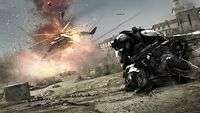 |
 |
 |
 |
 |
Overall, like the single-player, this is a mode to keep an eye on. If Ubisoft iron out the bugs, it’ll be a good level multiplayer. It’ll never match the likes of CoD or Halo or Gears or Battlefield, but it’ll definitely carve out a niche for itself, and I can see this MP having a long and fruitful life. It’s the sort of game that can be as deep as you want it to be, and I have no doubt that it will create maniacal fans that will play until the last server is shut down, in years to come.
Ghost Recon: ALPHA – Short Film
 This is the first short film to be released by Ubisoft Motion Pictures. But you couldn’t tell. If this film had a message, it’d be “HERE WE ARE, MOTHERFUCKERS. WE’RE UBISOFT, AND WE DON’T JUST MAKE GAMES ANYMORE!” Seriously. I can’t really say too much without giving the film away (it’s only about 15 minutes long), but oh my God, if you can get hold of a copy, do. I’ve spent the better part of the last two years picking films apart with a film/cinematography student that I live with, and like to think that qualifies me to give some sort of valid opinion on the old movin’ pictures.
This is the first short film to be released by Ubisoft Motion Pictures. But you couldn’t tell. If this film had a message, it’d be “HERE WE ARE, MOTHERFUCKERS. WE’RE UBISOFT, AND WE DON’T JUST MAKE GAMES ANYMORE!” Seriously. I can’t really say too much without giving the film away (it’s only about 15 minutes long), but oh my God, if you can get hold of a copy, do. I’ve spent the better part of the last two years picking films apart with a film/cinematography student that I live with, and like to think that qualifies me to give some sort of valid opinion on the old movin’ pictures.
So let me start by saying this: Ghost Recon: ALPHA is a balls-out parade of everything Ubisoft Motion Pictures can achieve. I’m appalled and saddened that this film was only short. I want more film-making of this quality, and I want it daily. The cinematography was incredible – the camera always showed exactly what you wanted to see. The violence was gratifying without being vulgar, the action ramped up in perfect pace (mimicking the flow of the game beautifully) and the acting was what you’d expect from a AAA-Hollywood release (the actors were at the screening and were surprisingly modest and pleasant chaps, too).
The effects in the film were believable without being cheesy or too sci-fi, and everything was pulled off with a professionalism that I honestly wasn’t expecting. The soundtrack was composed by Daniel Pemberton and orchestrated by Andrew Skeet (who worked on the album of orchestral re-imaginings of video games music, released last year). It was awesome (in the traditional sense of the word) – it was soaring, relevant and compounds what you see on screen with style and skill.
 The whole thing looks really pretty, too. The rumours flying around are that the film had £8-10 million to play around with, and it shows. Everything looks genuine – even the fancy/weird tech. Nothing lets this film down. Continuing the theme of authenticity that the game itself is so keen to promote, the film production hired an ex-squaddie they referred to as ‘Harry’ to train the actors in realistic combat movement. According to one of the film’s two directors, Francois Alaux, this wasn’t an easy task: “[initially], everyone had bad movement – these were not soldiers. One was a gamer, one a dancer and the other a vegetarian! But ‘Harry’ trained them properly and, by the end of filming, everyone was walking around like a trooper!” NB – ‘Harry’ was also the consultant on the set of Black Hawk Down.
The whole thing looks really pretty, too. The rumours flying around are that the film had £8-10 million to play around with, and it shows. Everything looks genuine – even the fancy/weird tech. Nothing lets this film down. Continuing the theme of authenticity that the game itself is so keen to promote, the film production hired an ex-squaddie they referred to as ‘Harry’ to train the actors in realistic combat movement. According to one of the film’s two directors, Francois Alaux, this wasn’t an easy task: “[initially], everyone had bad movement – these were not soldiers. One was a gamer, one a dancer and the other a vegetarian! But ‘Harry’ trained them properly and, by the end of filming, everyone was walking around like a trooper!” NB – ‘Harry’ was also the consultant on the set of Black Hawk Down.
The team behind this film took it very seriously – it wasn’t just another cheap, videogame tie-in. From listening to what the directors had to say at the screening, my respect for them increased tenfold. They really know their stuff. “When we looked at the game, we didn’t want to just take a bit of it and make it into a film; we wanted to show a full mission, and we thought giving [the audience] a prologue was the best way to do that.” The events seen in ALPHA are relevant to missions you’ll play in the game, and act as a springboard for the narrative you’ll play through.
“We wanted to show you what it’s like to be a real [ops] person – they’re always outnumbered and outgunned, but it’s they who have the element of surprise, so they can trigger the combat when it suits them,” explains Alaux. The director of the game itself, Geffroy, pitched in at this point to say this philosophy was shared in the production of Future Soldier, too. If nothing else, that approach makes for some bloody amazing viewing. I was rapt for the full ten minutes, and I would be if I watched it again.
 |
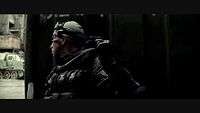 |
 |
 |
 |
 |
The CGI and visual effects were akin to what I’ve recently seen in The Avengers. No, I’m not exaggerating. I’m a gamer (as I’m sure you are) and, as such, I’ve become adept at discerning graphics from live action. I could barely tell in this – the inclusion of certain mechs and devices was amazing, and how the team at Ubisoft Motion Pictures bought them to life was inspiring. “Working with bringing the tech to life [in film] allowed us to see what worked and what didn’t, and that limited us quite a lot. The upside of this was that we could see our limitations and impose them in game – this allowed for more authenticity,” the directors explained.
I apologise that I couldn’t be more precise about any of this, but I really don’t want to ruin anything for you. Just see it. You’ll thank me, I promise. ALPHA is a shining moment in the infancy of Ubisoft Motion Pictures, and I seriously hope the team behind it go on to either make a full-length film, or go on to produce many, many more productions.
Last five articles by Dom
- Defining Games, Part I: ‘Culture’
- Best of 2012 - 10 Games and Their Classic 8-Point Story Arcs
- 10 Games and Their Classic 8-Point Story Arcs
- Tekken Tag Tournament 2 - Review
- Tom Clancy’s Ghost Recon: Future Soldier - MP, Campaign, and Film Preview



























ghost recon future soldier really is completely crazy. I managed to get a beta key download
I sunk over 20 hours into the beta in the first couple of days as it felt like a really promising skilful shooter, something I haven’t seen in so many years. However, I’ve now lost all interest in the game, as the developers seem intent on making the game accessible more than anything else. They’ve nerfed the Rifleman class (which is the only pure one), and made the silly sensory gadgets even more over-powered. It’s just mad, as if they have no idea what they’re doing. They want a heavy, team-based game, yet these additions remove ANY need for communication, call-outs and teamwork, as these futurustic devices just point out the enemy for you. One guy sat back playing as an Engineer is akin to a full team working together… and that just isn’t right. My friends and I have all submitted 1000s of words of feedback to the devs, but it’s clear they’re only interested in feedback telling them they’re doing a great job (the only forum threads they’ve replied to are those full of unprecedented praise, completely ignoring suggestions and comments on balance issues).
I’m still oily as hell for this game. I can even see meself playing it against randoms. The MP beta still hasn’t dampened my ardour.
After all, GRAW > COD despite any flaws.
I actually find it fascinating that Ubi have not only got their own film studio now, but that they seem to have hit the ground running with their short film. Let’s hope that they can continue to maintain the quality that got you so excited! Wait for an Assassin’s Creed film… it is bound to happen!
Dom, you and words should get married.
In seriousness, it sounds like a brilliant take on the genre, but probably not one that’s going to have me crawling back to it anytime soon. I’ll definitely be giving the movie a watch though, it sounds incredible.
Thanks, this is by far the best preview of the game currently available online.
I have two follow-up questions:
i. Have you been part of the Ghost Recon Online Beta and, if so, would you care to compare it to GRFS MP? Personally i consider GRO quite stunning,, truly groundbreaking in fact. and GRFS MP will have to be much more impressive and innovative than you indicate in your preview to command my loyalty over GRO. I’m glad GRFS offers coop, though.
ii. By far the most disturbing criticism you make of the game (in SP and MP) is its crude controls. In any tactical shooter you HAVE to get movement controls and the cover mechanic right. Do you think this will be any better in the PC version?
Again, thanks for an excellent and useful preview.